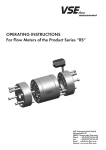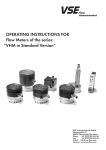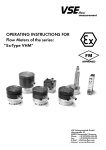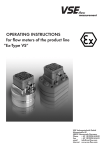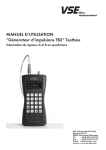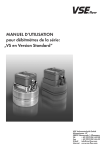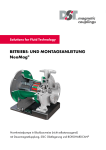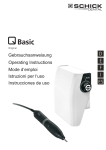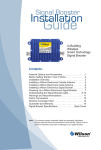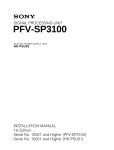Download OPEratING INStructIONS For Flow Meters of the Product Series ”rS“
Transcript
Operating Instructions For Flow Meters of the Product Series ”RS“ VSE Volumentechnik GmbH Hönnestraße 49 58809 Neuenrade/Germany Phone + 49 (0)23 94/616 30 Fax + 49 (0)23 94/616 33 Email [email protected] Internet www.vse-flow.com 1 Table of Contents Page Important Basic Information. . . . . . . . . . . . . . . . . . . . . . . . . . . . . . . . . . . . . . . . . . . . . . . . . . . . . 3 1. Function Description of the RS Flow Meters. . . . . . . . . . . . . . . . . . . . . . . . . . . . . . . . . . . . . . 3 2. General Description. . . . . . . . . . . . . . . . . . . . . . . . . . . . . . . . . . . . . . . . . . . . . . . . . . . . . . . . . 4 3. RS Flow Meter Selection. . . . . . . . . . . . . . . . . . . . . . . . . . . . . . . . . . . . . . . . . . . . . . . . . . . . . . 4 4. Declaration of Conformity. . . . . . . . . . . . . . . . . . . . . . . . . . . . . . . . . . . . . . . . . . . . . . . . . . . . . 4 5. General Operating Requirements . . . . . . . . . . . . . . . . . . . . . . . . . . . . . . . . . . . . . . . . . . . . . . 4 6. Maximum Operating Pressure. . . . . . . . . . . . . . . . . . . . . . . . . . . . . . . . . . . . . . . . . . . . . . . . . 5 7. Information about the EU Pressure Equipment Directive 97/23/EC. . . . . . . . . . . . . . . . . . . . 5 8. Flow Rate Measuring Range . . . . . . . . . . . . . . . . . . . . . . . . . . . . . . . . . . . . . . . . . . . . . . . . . . 5 9. Mounting the Flow Meter. . . . . . . . . . . . . . . . . . . . . . . . . . . . . . . . . . . . . . . . . . . . . . . . . . . . . 6 10. Cleaning and Flushing of Pipeline before Initial Start-Up. . . . . . . . . . . . . . . . . . . . . . . . . . . 6 11. Fluid Filtering. . . . . . . . . . . . . . . . . . . . . . . . . . . . . . . . . . . . . . . . . . . . . . . . . . . . . . . . . . . . . . 7 12. Sensor Electronics Function . . . . . . . . . . . . . . . . . . . . . . . . . . . . . . . . . . . . . . . . . . . . . . . . . . 7 13. Pulse Filtering . . . . . . . . . . . . . . . . . . . . . . . . . . . . . . . . . . . . . . . . . . . . . . . . . . . . . . . . . . . . 10 14. Programming the Preamplifier Electronics . . . . . . . . . . . . . . . . . . . . . . . . . . . . . . . . . . . . . . 11 15. Signaling LEDs. . . . . . . . . . . . . . . . . . . . . . . . . . . . . . . . . . . . . . . . . . . . . . . . . . . . . . . . . . . . 12 16. Operating Mode Messages. . . . . . . . . . . . . . . . . . . . . . . . . . . . . . . . . . . . . . . . . . . . . . . . . 12 17. Alarm and Warning Messages. . . . . . . . . . . . . . . . . . . . . . . . . . . . . . . . . . . . . . . . . . . . . . . 13 18. Preamplifier Technical Data. . . . . . . . . . . . . . . . . . . . . . . . . . . . . . . . . . . . . . . . . . . . . . . . . 13 19. Preamplifier Pin Assignment. . . . . . . . . . . . . . . . . . . . . . . . . . . . . . . . . . . . . . . . . . . . . . . . . 13 20. Maintenance. . . . . . . . . . . . . . . . . . . . . . . . . . . . . . . . . . . . . . . . . . . . . . . . . . . . . . . . . . . . . 14 21. Returning for Repairs and Sample Devices. . . . . . . . . . . . . . . . . . . . . . . . . . . . . . . . . . . . . 15 22. RS Flow Meter Technical Data. . . . . . . . . . . . . . . . . . . . . . . . . . . . . . . . . . . . . . . . . . . . . . . 15 23. RS Flow Meter Flow Characteristics . . . . . . . . . . . . . . . . . . . . . . . . . . . . . . . . . . . . . . . . . . 16 24. RS Flow Meter Dimensions. . . . . . . . . . . . . . . . . . . . . . . . . . . . . . . . . . . . . . . . . . . . . . . . . . 17 25. RS Flow Meter Type Code . . . . . . . . . . . . . . . . . . . . . . . . . . . . . . . . . . . . . . . . . . . . . . . . . . 18 26. Pin Assignment. . . . . . . . . . . . . . . . . . . . . . . . . . . . . . . . . . . . . . . . . . . . . . . . . . . . . . . . . . . . 18 27. Connection Diagram. . . . . . . . . . . . . . . . . . . . . . . . . . . . . . . . . . . . . . . . . . . . . . . . . . . . . . . 19 The current publication of this operating instruction supersedes all information from previous publications. VSE reserves the right to make changes and substitutions. VSE is not liable for any printing errors. Reproduction, including excerpts, is permitted only after written approval by VSE. VSE reserves the right to modify technical data at any time. Last revised: 12/2012 2 Important basic information Dear customer, dear user, These installation and operating instructions should provide you with the information you need to properly install and commission the flow meter. Installation, commissioning and testing are to be performed by trained and qualified personnel only. These operating instructions must be read and applied carefully to ensure proper, trouble-free and safe operation of the flow meter. VSE is not liable for any damage incurred resulting from not complying with the instructions in this operating instruction. It is not permitted in any case to open the device. These operating instructions for flow meters of the series ”RS” from VSE must be stored, so that they can be read by the group of authorized personnel at any time. Chapters may not be taken of these instructions at any time. A missing operating instructions manual or missing pages must be replaced immediately. VSE can supply you with new instructions or you can download the operating instructions from the internet (www.vse-flow.com). The operating instructions must be given to each subsequent user of this product. Legal information This document is not managed by an updating service of VSE Volumentechnik GmbH. Changes to this document may be made without notice. VSE Volumentechnik GmbH does not provide any implicit guarantees of commercial qualities and suitability for a specific purpose. If the device has been opened, modified or incorrectly connected to the electrical circuits, the guarantee of VSE Volumentechnik GmbH for safe operation is void. VSE Volumentechnik GmbH is not liable in any way for personal injuries or damage to goods resulting from improper installation or improper operating of the flow meter. 1. Function Description of the RS Flow Meters RS flow meters measure the flow rate based on the screw pump principle. A pair of rotors fitted precisely into the housing constitutes the measuring element. An integrated gear and non-contact signal pick-up system detects the rotations of the measuring element and converts them to digital pulses. Sensor System Explanation The non-contact pick-up system consists of two GMR bridges (sin /cos), which are located in a sensor unit in cartridge design. It detects the movement of the sensing gear and routes the sin/cos signals to the preamplifier electronics. Together with the housing walls, the rotor edges form closed measuring chambers in which the fluid is transported from the inlet to the outlet side. The preamplifier electronics digitise and amplify the sensor signals and multiply them by a high-resolution interpolator using adjustable settings. The square wave signals are bidirectional and can be utilised by any evaluating instrument as well as computers and PLC controls. The fluid volume put through within one main rotor rotation is the rotation volume, which is divided by the sensing gear and digitised, processed and output in the sensor module. The resolution is selectable in steps from factor 1 to 128. In case of a 1-channel evaluation, a separate directional signal is available. Advantages •High degree of precision that is mostly independent of viscosity •Pulsation-free measurement •Lowest pressure losses •Short response time due to innovative rotor profile and •Highest functionality due to intelligent sensor technology •Gentle fluid measurements An adjustable pulse filter can offset and suppress negative flows (e.g. generated by vibrations) while still in the device. The frequency of the output signals is proportional to the flow (volume flow) and depends on the respective flow meter size. The frequency range is from 0 to 100 kHz. The preamplifier is protected against reverse polarity and incorrect connection. It is designed for media temperatures of -30°C to +120°C and is mounted directly on the RS flow meter. 3 2. General Description Please follow all instructions in this manual to ensure the trouble-free operation of the RS flow meters.VSE does not assume responsibility or liability for damages resulting from noncompliance with these instructions. The device may only be opened within the warranty period after consultation and approval by VSE. 3. RS Flow Meter Selection For the trouble-free, safe, and reliable operation of the flow meters, selecting the correct type and size is critical. Because of the wide variety of applications and flow meter designs, the technical data in the VSE catalogue are general in nature. Certain properties of the devices are dependent on type, size and measuring range, as well as the liquid to be measured. Please contact VSE or one of our sales and service representatives for detailed information about the appropriate flow meter for your particular application. 4. Declaration of Conformity Flow meters of the ”RS“ series have been tested for their electromagnetic compatibility and interference emissions as outlined by the EMC Directive and are in compliance with the applicable statutory EMC Directives. They cannot be operated independently, are connected by cable to a power source, and provide digital electrical signals for electronic evaluation. All flow meters have a declaration of conformity, which can be requested if necessary. Since the electromagnetic compatibility of the entire measuring system is also dependent on the installation of the cables, the correct connection of the shield, and each individual connected device, all components must comply with the EMC Directive, and the electromagnetic compatibility of the entire system, machine, or system must be ensured as well. All flow meters have been tested in accordance with the applicable statutory EMC Directives of EN 61000-6 and are CE certified. The EC conformity marking is the CE mark affixed to all flow meters. 5. General Operating Requirements Before assembly or putting into operation (commissioning), check and verify the following properties and aspects of the respective circumstances of your system to ensure operation is trouble-free, safe, and reliable. 1. The Fluid to be Processed Is the flow meter suitable for the fluid? Is the fluid viscous or abrasive? Is the fluid dirty or does it contain contaminants/pollutants and solid particles? Which grain sizes do these solids have and could they block the measuring element? Does the fluid have fillers or other additives? Is it necessary to install an upstream hydraulic filter? Are tubes and pipes clean and free of assembly residues such as chips, weld spatter? Is the tank clean and is it impossible for impurities or foreign substances to reach the pipeline or tubing system from the tank? Is a different fluid used frequently and is the system sufficiently flushed and rinsed in between? Are pipelines/tubes and the entire system completely deaerated? Which cleaning agent is being used? Are fluid and cleaning agent compatible with the seals? Are the seals suitable for the fluid to be measured (compatibilities of seals)? 2. Hydraulic Properties of the System Is the max. operating pressure of the system less than the max. permissible operating pressure of the flow meter? Is the max. pressure drop ∆p (at flow meter) below the max. permissible pressure drop? Is the pressure drop ∆p not excessive with max. flow (e.g. high viscosity)? Does the flow range of the flow meter (dependent on the viscosity) correspond with the present flow? Please note that the flow range is less with higher viscosity! Does the temperature range of the flow meter correspond with the present max. temperature of the fluid? Is the cross-section of the pipelines/tubes large enough and are there no overly large pressure drops in the system? Is the hydraulic connection (inlet/outlet) connected corrected and sealed properly? Does the pump have enough power to operate the system? A blocked flow meter can stop the entire flow. Does the system feature an overpressure / bypass valve? This valve must be checked and maintained at regular intervals. 4 3. Electronic Evaluation and Electrical Safety Have you selected the optimal flow sensor and is this equipped with the appropriate preamplifier? Does the supply voltage of the flow meter match the available power supply? Is the supply voltage to the power supply adapter or the evaluating device sufficiently filtered? Does the output of the supply voltage correspond with the required output? Is the electrical connection established based on the enclosed wiring plan? Is the cable shield correctly connected to both sides of the protective earth conductor (PE)? Is there a potential difference between the PE on the flow meter and the PE at the evaluating device? Is a compensation line to eliminate the potential difference needed between the flow meter and the evaluating device? Is the flow meter permanently attached to the protective earth conductor (PE) (e.g. via the pipelines)? Is the measuring element of the flow meter insulated to the protective earth conductor (PE) (e.g. connection via pipes/tubes)? If this applies, the measuring element must be connected with the protective earth conductor (PE)! Is a continuous connection of the cable shielding (protective earth conductor [PE]) installed via the housing, the 4-pin to 5-pin round pin plug to the measuring element of the flow meter? Is the cable installed free of interference and is it impossible to couple interfering impulses? Is the 4-pin to 5-pin round pin plug of the connection cable firmly attached to the plug of the flow meter? Are the wires at the evaluating device connected correctly? Does the entire system meet the legal rules and regulations concerning electromagnetic compatibility (EMC)? Is compliance with all local rule and regulations, applicable rules, guidelines and basic conditions of the EMC ensured? Systems where a malfunction or failure may lead to personal injuries must be equipped with suitable safety mechanisms. The function of these safety mechanisms must be checked at regular intervals. 6. Maximum Operating Pressure Before installing the flow meter, you must check whether the max. operating pressure of the system does not exceed the max. permissible operating pressure of 450 bar of the flow meter. Make sure to keep in mind that peak pressures may occur when operating the system. Important: Please contact VSE with all operating pressures > 450 bar and in case of special models. 7. Information about the EU Pressure Equipment Directive 97/23/EC VSE flow meters of the ”RS“ series qualify as „pressure equipment“ as defined by Section 1, Paragraph 2.1.4. of the directive listed above and as such are affected by the regulations of this directive. VSE flow meters must therefore meet the technical requirements specified in Section 3, Paragraph 1.4 of the directive. The fluids to be measured are for the most part Group 2 fluids acc. to Section 9, Paragraph 2.2. VSE flow meters do not reach the limit values specified by Section 3, Paragraph 1.1. The technical requirements for VSE flow meters are therefore confined to the criteria specified in Section 3, Paragraph 3. This means that the devices must be designed and manufactured in accordance with the provisions of good engineering practice applicable in a member state. This is hereby confirmed. The section also stipulates that such pressure equipment and components or accessories are not allowed to bear the CE marking in accordance with the Pressure Equipment Directive. This means that a declaration of conformity is not issued for VSE flow meters and the devices are not provided with the CE mark as pertaining to Directive 97/23/EC. 8. Flow Rate Measuring Range The flow rate measuring range specified in the data sheet (Qmin – Qmax) of the flow meter refers to the test fluid ‚hydraulic oil‘ with a viscosity of 21 mm2/s at a temperature of 20°C. For this measuring range, VSE specifies accuracy up to 0.3% of the measured value and a repeatability of 0.05%. In fluids with low viscosity (< 21 mm²/s), the measurement accuracy degrades while it may improve with fluid with a high viscosity (> 21 mm²/s). Note also that the flow measuring range is limited at higher viscosity (see data sheet of the flow meter). The characteristic pressure loss curves are listed in Section 23. Important: Verify that the specified maximum permissible operating pressure of the flow meter can never be exceeded in any operating mode of the system. Also pay attention to the flow measuring range, which is dependent on the viscosity of the fluid to be measured. 5 9. Mounting the Flow Meter Non return valve The flow meter should be mounted in an easily accessible location so that disassembly to clean the measuring elements is easy. Since flow meters operate in any installation position and flow direction, you can mount it anywhere in your system. When installing the flow meter, make sure that liquid remains in the flow meter even at standstill of the system and that the flow meter can never run dry. The outlet of the flow meter should always have a certain backpressure since this fixes the measuring element of the flow meter in the liquid column (the measuring element uses to support itself on the liquid column) and the pipeline cannot empty itself. In critical cases, or if the pipeline can run empty in standstill or standby mode, it is always advisable to install an additional non-return check valve in the outlet line. Flow meter Tank Fig. 1: Flow meter with backpressure Important: Make sure that the flow meter measuring elements are always completely filled both in inflow and outflow and that the outflow has a little backpressure. This prevents the measuring elements from being damaged by a sudden and steep increase of flow and at the same time improves measurement accuracy. Flow meters of the ”RS“ series can be installed in the pipeline. Always select large cross-sections (if possible) for the hydraulic inlet and outlet or the entire pipeline system. This reduces the pressure drop and the flow rate throughout the system. Installation Notes Installation Position Any, note arrow indicating preferred direction if necessary (calibration arrow).Mount the device in such a way that the preamplifier is turned away from any potential heat source. Straight pipe sections are not required in inlet/outlet. Pipe Thread Please comply with the screw-in depths and sealing systems. Teflon tape or liquid sealants such as adhesives are not permitted! Fastening The devices must be installed stress-free into the pipeline. This is accomplished with fastening screws located at the face sides in the connecting units. For stress-free assembly, the compressive strength may be limited! Tabelle 1: Starting torque of the connection units RS Flow Meter Size Connecting Units If the connecting units (mounting flanges) are to be installed on-site, compliance with the specified torque is required. Torque RS 100 70 Nm RS 400 120 Nm RS 800 240 Nm RS 2500 160 Nm 10. Cleaning and Flushing of Pipeline before Initial Start-Up Before initial start-up of the flow meter, you must flush and clean the whole system to prevent contaminants from reaching the measuring elements during the assembly and installation. Foreign matter or contaminants may block the flow meter or severely damage it so that the flow meter readings are no longer valid and the device must be returned for repairs. After completion of the installation or piping, you must first flush the entire pipeline system and carefully clean and flush the tank. This requires that the flow sensor is removed from the fluid circuit to flush out all foreign matter or contaminants (e.g. chips, metal parts) without problems. Use a rinsing fluid that is compatible with the subsequent used fluid and will not cause adverse reactions. Such information can be obtained from the supplier or manufacturer of the fluid or from VSE. 6 Flow meters are sensors manufactured with a high degree of precision. They have mechanical measuring elements consisting of two rotors fitted into the housing with narrow gaps. Even the smallest damage to the rotors causes a measuring error. Always make sure that foreign matter or contaminants cannot reach the measuring elements and that the fluid flowing through the flow meter is always free of pollutants and particles. Once the system is thoroughly flushed and no extraneous material is in the piping system, you can mount the flow meter into the fluid circuit and start the actual initial startup process. 11. Fluid Filtering Heavily contaminated fluids or foreign matter in the fluid can block, damage, and even destroy the flow meter. In these cases, always install a sufficiently large filter in front of the flow meter so that foreign particles and solids are prevented from entering the measuring elements, thus preventing damage to the flow meter. The required filtering depends on the size, bearing, and design of the flow meter. Table 2: Upstream filters Flow meter size Filter size for ball bearing RS 100 250 µm RS 400 250 µm RS 800 500 µm RS 2500 500 µm The filter size for flow meters with slide bearings, in special designs, or with specially adapted measuring element tolerances can be obtained from VSE GmbH upon request. Important: A blocked flow meter is capable of stopping the entire flow. An overpressure / bypass valve must be installed in the system side. 12. Sensor Electronics Function The liquid to be measured flows through the rotor chambers in axial direction, resulting in an even rotation of the screw spindles. The resolution is selectable in steps from factor 1 to 128. The frequency range is from 0 to 100 kHz. This is done especially gentle and with very low resistance for the fluid to be measured as well as pulsation-free and almost free of leaks due to the specially designed fluidic profile geometry. In case of a 1-channel evaluation, a separate directional signal is available. A magnet wheel permanently affixed to the rotors is scanned without contact with a sensor module. The non-contact pick-up system consists of two GMR bridges (sin /cos), which are located in a sensor unit in cartridge design. It detects every movement of the sensing gear and routes the sin/ cos signals to the preamplifier electronics. The preamplifier electronics digitise and amplify the sensor signals and multiply them by a high-resolution interpolator using adjustable settings. The square wave signals phase-shifted by 90° are bidirectional and can be utilised by any evaluating device as well as computers and PLC controls. The flow is proportional to the edges/pulse count and the flow rate is proportional to the frequency. The adjustable interpolator can be used to adjust the resolution explicitly to the downstream connected evaluating unit for obtaining highly precise measuring results of the entire system. This applies to the following application cases, for example: • Measuring, controlling, and regulating high viscosity fluids • Measuring, controlling, and regulating in lower flow ranges • Measuring, controlling, and regulating when passing through zero • Measuring, controlling, and regulating in both flow directions • Measuring, controlling, metering, and filling of small volumes The preamplifier is protected against reverse polarity and incorrect connection. It is designed for fluid temperatures of -30°C up to +120°C and is mounted directly on the RS flow meter. The fluid volume passed through by one gear division of the sensing wheel within the measuring element is divided by the set interpolation factor. This forms the measurement volume per pulse (Vm) with the defined unit [cm³/pulse]. The frequency of the output signals can be calculated as follows: Formula 1: Calculation of the output frequency with Q in l/min f= Q x 1000 Vm 60 Table 2, Formula 2, and the subsequent diagrams can be used to determine the corresponding resolution or the corresponding IPF for the respective application. Adjustable interpolation factors IPF: 1, 2, 5, 10, 25, 32, 50, 64, 100, 128 7 Table 3: Measurement volumes and K-factors RS 100 RS 400 Interpolation factor (IPF) Switch position S3 1 0 2 5 Measurement volume Vm [cm3/Imp] Interpolation factor (IPF) Switch position S3 6510 1 0 3,138 3439 13020 2 1 1,569 637 2413 8598 32549 5 2 0,6276 1593 6032 K-Factor [Imp/l] K-Factor [Imp/ gal.] 0,5815 1720 1 0,29075 2 0,11630 Measurement volume Vm [cm3/Imp] K-Factor [Imp/l] K-Factor [Imp/ gal.] 319 1206 10 3 0,05815 17197 65098 10 3 0,3138 3187 12063 25 4 0,02326 42992 162745 25 4 0,12552 7967 30158 32 5 0,01817 55036 208335 32 5 0,09806 10198 38603 50 6 0,01163 85985 325489 50 6 0,06276 15934 60316 64 7 0,00909 110011 416440 64 7 0,04903 20396 77207 100 8 0,00582 171821 650419 100 8 0,03138 31867 120632 128 9 0,00454 220264 833797 128 9 0,02452 40783 154382 K-Factor [Imp/l] K-Factor [Imp/ gal.] 27 102 RS 800 RS 2500 Interpolation factor (IPF) Switch position S3 1 0 Measurement volume Vm [cm3/Imp] K-Factor [Imp/l] K-Factor [Imp/ gal.] 10,00000 100 379 Interpolation factor (IPF) Switch position S3 Measurement volume Vm [cm3/Imp] 1 0 37,00000 2 1 5,00000 200 757 2 1 18,50000 54 204 5 2 2,00000 500 1893 5 2 7,40000 135 511 10 3 1,00000 1000 3785 10 3 3,70000 270 1022 25 4 0,40000 2500 9464 25 4 1,48000 675 2555 32 5 0,31200 3200 12113 32 5 1,15625 864 3270 50 6 0,20000 5000 18927 50 6 0,74000 1350 5110 64 7 0,15625 6400 24227 64 7 0,57813 1728 6540 100 8 0,10000 10000 37854 100 8 0,37000 2700 10220 128 9 0,07813 12799 48451 128 9 0,28906 3456 13081 Formula 2: Calculating the max. IPF IPF ≈ fmax x VmIPF1 x 60 Qmax x 1000 The set IPF may not be larger than the calculated IPF! IPF fmax VmIPF1 Qmax 8 Interpolation factor Max. processable input frequency Measurement volume with IPF = 1 (volume of a gear structure of the sensing wheel) Max. operating flow in l/min Flow diagrams vs frequency RS 100 Flow vs frequency RS 400 Flow vs frequency 9 RS 800 Flow vs frequency RS 2500 Flow vs frequency Example Flow meter: RS 400 Max processable input frequency of the downstream evaluating unit: 20 kHz Max. operating flow: 140 l/min Path 1: The diagram yields an IPf of 25 Path 2: 1 IPF ≈ fmax x VmIPF1 x 60 = 20.000 s x 3,138 ml x 60 s = 26,9 ≈ 25 Qmax x 1000 140 1000 ml 10 13. Pulse Filtering Oscillations in fluid systems manifest themselves through constant forward and backward movements of the liquid column, which is also detected by the rotor sensors and converted into proportional electronic pulses or edge sequences. Depending on the application, oscillations or vibrations can occur during the flow rest phases or discontinuous flows. The pulses generated during the osciallation phase can be incorrectly interpreted by the downstream evaluating unit or controller, which can be very distracting for the respective operating process. of the rotor measuring unit. The signals at the channel outputs are also suppressed at the same time until the internal offset is equalized or the initial position of the rotor measuring unit has been reached again (see Fig. 3). The user is able to set the degree of filtering in the form of partial volumes using rotary coding switches. Adjustable pulse filtering: 0Z, 0.25Z, 0.5Z, 0.75Z, 1.0Z, 1.25Z, 1.5Z, 1.75Z, 2.0Z, 2.25Z, 2.5Z, 2.75, 3.0Z, 3.25Z, 3.5Z, 3.75Z (Z: gear unit) The signal filtering function of the internal electronics continuously offsets these generated edges during the rapid forward and backward movements Fig. 3: Pulse filtering principle Table 4: Suppressed volume with pulse filtering activation [ml] 14. Programming the Preamplifier Electronics The electronics elements are quickly and easily set. There are two rotary coding switches on the electronics (S3, S4), a jumper (B2), a switch (S2) and a key (S2). With the rotary coding switches, the IPF and the degree of filtering are programmed. Filter position RS 100X RS 400X RS 800X RS 2500X 0 0 0 0 0 1 0.145375 0.7845 2.5 9.25 2 0.29075 1.569 5.0 18.50 3 0.436120 2.3535 7.5 27.75 4 0.5815 3.138 10.0 37.00 5 0.726875 3.9225 12.5 46.25 6 0.87225 4.707 15.0 55.5 7 1.017625 5.4915 17.5 64.75 8 1.163 6.276 20.0 74.00 9 1.308375 7.0605 22.5 83.25 10 (A) 1.45375 7.845 25.0 92.50 S1 11 (B) 1.599120 8.6295 27.5 101.75 S2 12 (C) 1.7445 9.414 30.0 111.00 13 (D) 1.889875 10.1985 32.5 120.25 14 (E) 2.03525 10.983 35.0 129.50 15 (F) 2.180625 11.7675 37.5 138.75 B2 S4 S3 Fig. 4: Preamplifier electronics 11 During initial startup, the switch S2 must first be set to the corresponding preferred direction of the flow. The positive flow direction of the RS flow meter system is specified in the top view of the 5-pin M12 connector. In this case, the switch S1 must be set to ON. For the opposite negative direction, the switch position is to be down and thus set to OFF. This setting ensures that the pulse filtering is activated in the right direction from the very beginning after switching on the supply voltage. Pin 5 of the M12 connector is either used for the separate direction signal or an error signal. This is set accordingly with the bridge B2. The figure above depicts the bridge attached to the middle and right pin of the 3-pin row of pins, which routes the separate zero signal to the third output. If the bridge is on the left and middle pin, the error signal in case of a fault is output. A description of the error states is found in the ”Alarm and Warning Messages“ chapter. Ten different interpolation factors can be set with the coding switch S3. The corresponding interpolation factors for the respective switch positions are listed in Table 3. This setting can be changed at any time while the system is running. Simply use a small screwdriver to adjust the rotary coding switch and then briefly press the S2 key for the acknowledgment. The new pulse rate is enabled a once. The rotary coding switch for the pulse filtering has 16 switch settings. The degree of filtering is determined with quarter gear division increments. The corresponding suppressed partial volumes of the respective size are listed in Table 4. Changes can also be performed during operation and become active after pressing the S2 key. The electronics is sensitive to electrostatic discharges. People making adjustments to the electronics must first discharge their electrostatic charges using a grounded object. Important: People making adjustments to the electronics must first discharge their electrostatic charges using a grounded object. 15. Signaling LEDs The signaling LEDs provide information about the corresponding status of the electronics. These include certain operating and fault states (see Figure 5). The three LEDs have a different combination of states for each signal. The LEDs signal either operating modes or alarms and warnings. Operating mode messages signal the respective mode that has been set. Alarm and warning signals provide explicit information about overload, conditions that can negatively affect the measurement, or component errors of the measuring system. Fig. 5: Signaling LEDs of the preamplifier electronics 16. Operating Mode Messages Table 5: Operating mode messages Mode Yellow LED Green LED Red LED Error output Normal operation off on off off Offset mode off Flashes off off 12 Yellow Green Red 17. Alarm and Warning Messages The electronics of the RS flow meters can detect five events that could lead to measurement errors. In case of serious errors, the third output has a ”high“ signal or a ”pulse“ signal if activated with the bridge B1. The different error causes can be determined with the states of the three LEDs. The red LED is linked with the error output. Each active state of this LED or the error output signals an event that has negative effects on the measurements. Table 6: Alarm and warning messages Warning Yellow Green LED LED Offset adjustment necessary 1 Flashes on Red LED Error output off off Description of the Error Messages 1.Offset adjustment necessary: The sensor and/or the preamplifier elec- tronics were replaced. A different size was set. 2.Electronics errors: Defective component in interpolator circuit, unable to determine internal configuration values Alarm Interpolator electronics errors 2 Yellow Green LED LED Red LED Error output Flashes Pulse 3.Pick-up errors: The sensor is defective or quit working. The distance bet- ween the sensor and the magnet wheel has changed = mechanical damage Flashes off Error at pick-up 3 off on / off on on Flow overload on off on on max. frequency range exceeded (>100 kHz) 4 on on Flashes Pulse 5.Frequency errors: The max. output frequency of 100,000 Hz was excee- ded. The IPF is dimensioned too high for the respective flow Flashes on Flashes Pulse 6.Temperature errors: The temperature of the fluid is too high (> 120°C) and may result in flawed or incorrect measurements Fluid temperature > 120°C 5 4.Overload: The maximum permissible flow range was exceeded 18. Preamplifier Technical Data Scanning sensor 2 x GMR sensors in a bridge circuit (sin/cos) Adjustment automatic offset adjustment Resolution programmable 1, 2, 5, 10, 25, 32, 50, 64, 100, 128 Adjustable pulse filtering 0Z, 0.25Z, 0.5Z, 0.75Z, 1.0Z, 1.25Z, 1.5Z, 1.75Z, 2.0Z, 2.25Z, 2.5Z, 2.75, 3.0Z, 3.25Z, 3.5Z, 3.75Z (Z: gear unit) Frequency up to 100 kHz Output signals Channel A, channel B, directional signal DIREC (high: positive, low: negative) or error signal ERROR (high or pulse: error) Channel A and B two signal outputs for outputting the digital flow sensor signals, a channel offset of 90° between channel A and channel B; Flow direction Detection of flow direction from the channel offset of the signals from channel A to channel B or via the separate direc- tional signal. Outputs Three current-limited and short-circuit-proof power amplifiers (channel A, channel B, DIREC / ERROR); integrated adjustment to a characteristic impedance of 75 Ω; driver current approx. 300 mA at supply of 24 V; small saturation voltage of up to 30 mA load current, short switching times, integrated freewheeling diodes against Vb and GND, ther- mal shutdown with hysteresis; in case of error, the outputs are high impedance; The 24 V line drivers are designed for control applications with cable adjustment Error messages Electronics fault (e.g. faulty interpolator), sensor errors (e.g. sensor failure), offset adjustment necessary, overload (flow peaks), frequency error (> 100 kHz), temperature error (> 120°C) Operating voltage Vb = 10 … 28 VDC Current consumption lnoload = approx. 40 mA, total current consumption depends on output load 13 19. Preamplifier Technical Data Fig. 6 depicts the pin assignment of the preamplifier. This plug has five pins. Two pins are for the power supply (pin 1 and 3), two for the signal output of channel 1, 2 (pins 2 and 4) and a separate output for error or direction detection (pin 5). However, please note that the cable shield at the plug side is on the metal housing of the plug. The connection cable shield must be applied on both sides. The shield is used to connect the PE from the evaluation electronics to the preamplifier housing and the measuring element of the flow meter. The cable shield should always be continuous to the flow meter and not sepa- rated by distribution boxes or junction boxes. Route the connection cable as directly as possible from the evaluating device to the flow meter since interruptions are always potential sources of error. The measuring elements of the flow meter must be connected electrically with the protective earth conductor (PE). This is generally ensured with the grounded pipelines. If potential differences exist between the preamplifier housing and the protective conductor (PE) of the evaluating device, you must provide equalization. Pin 2 Digital signal Channel 1 Pin 1 Power supply Vb = 10-28 VDC Pin 5 Digital signal ERROR/DIREC Metal housing connected with shield and protective earthing conductor PE Pin 3 Power supply GND (-Vb = 0 V) Pin 4 Digital signal Channel 2 Plug top view Figure 6: Flange plug of the preamplifier housing Important: Use only well shielded connection cables with a wire cross-section of ≥ 4 to 5 x 0.25 mm². Please note that the housing of the round pin plug is metallic, has a connection for the shield and that the potential of the PE is connected to the cable shield and the housing of the preamplifier. Important: Please make sure that no additional inductors such as contactors, relays, valves, etc. are connected to the power supply of the flow meter. These components are potential sources of interference (especially if the inductors are not provided with adequate protective circuits), produce high interference pulses during the switching, and may disrupt the function of the flow meter even though it complies with the EMC directives. 20. Maintenance Depending on the operating conditions, the service life and thus the specific characteristics of the equipment are limited due to wear, corrosion, deposits, or aging. The operator is responsible for carrying out periodic inspections, maintenance, and re-calibrations. Each observation of a malfunction or damage makes it necessary to stop operation. We can loan a device for the duration of the overhaul if requested. We recommend an annual inspection and recalibration. 14 21. Returning for Repairs and Sample Devices Repairs on the flow meter and other components can be carried out quickly and efficiently only if you include detailed information about the claim or defect when returning the device. In addition, a safety sheet must be enclosed, clearly indicating what fluid has been used with the flow meter and how hazardous this fluid is. Compliance with the laws on occupational safety, such as Workplace Regulations (ArbStättV), Accident Prevention Regulations and Regulations on Environmental Protection, Waste Law (AbfG) and Water Act (WHG), require that businesses protect their employees and other people as well as the environment from harmful effects when handling hazardous substances. If additional precautions are required despite careful draining and cleaning of the flow meter, the associated required information must be included when returning the device. Please note that inspection and repair is only performed on flow meters returned to VSE GmbH if the safety sheet of the used fluid is enclosed and if the flow meter has been completely cleaned and flushed. This is to protect our employees and makes our work easier. In case of noncompliance with this rule, the devices are returned to the sender without attaching postage to the package. 22. RS Flow Meter Technical Data Overall size Measuring range (Qmax.) l/min. RV ccm/rev. VE ccm/Imp. K – Factor Imp./l min. K – Factor Imp./l max. P max. bar Filtering µm RS 100 0.50 – 100 (120) 15.7 0.5815 1,720 220,000 450 250 RS 400 1.00 – 400 (525) 56.5 3.138 318 40,800 450 250 RS 800 4.00 – 800 (1,000) 180.0 10 100 12,800 450 500 RS 2500 10.00 – 2,500 (3,000) 666.0 37 27 3,459 40 500 Frequency range 0 … 100 kHz, adjustable Measuring accuracy ± 0.3% [0.5%]*, [1%]** of measured value at viscosity of 21 cSt *RS 800, **RS 2500 Repeatability ± 0.05% with same operating conditions Materials Gray cast iron version EN-GJS – 400 – 15 (EN 1563) / 100 Cr 6 Stainless steel version Stainless steel 1.4305/1.4112, additional available upon request Bearing Fluid-dependent as anti-friction bearing or SSIC/wolfram carbide friction bearing Seals FPM (standard) PTFE, NBR, EPDM upon request Fluid temperature -30°C ... +120°C Viscosity range 1 … 1,000,000 cSt Installation position Any using selectable connection units, also customer specific Supply voltage 9 … 28 VDC Current consumption 65 mA at 24 VDC unloaded Delay time ≤ 8 mµs Protection type IP 65 15 23. RS Flow Meter Flow Characteristics Baugröße 100 Flow range 0 up to 0 120 Durchflussbereich bisl/min 120 l/min Flow range 0 up to 10 l/min Durchflussbereich 0 bis 10 l/min Flow range pressure drop∆p ∆p Durchflusswiderstand Flow range ipressure drop Durchflusswiderstand ∆p∆p Size 100 100 Baugröße Flow range Q Durchfluss Q Flow range Q Durchfluss Baugröße 100 Flow range 0 up to 0 500 Durchflussbereich bisl/min 500 l/min Flow range 0 up to 0 50bis l/min Durchflussbereich 50 l/min Flow range pressure drop∆p ∆p Durchflusswiderstand Flow range ipressure drop Durchflusswiderstand ∆p∆p Baugröße Size 400 400 Flow range QQ Durchfluss Flow range Q Durchfluss Q Size 2500 Flow range 0 up to 0 1,000 l/min l/min Durchflussbereich bis 1.000 Flow range 0 up to 3,000 l/min Flow range pressure drop ∆p Flow range pressure drop∆p ∆p Durchflusswiderstand Size 800 800 Baugröße Flow range QQ Durchfluss 16 Flow range Q 24. RS Flow Meter Dimensions RS 100 Preamplifier Vorverstärker Test Port Messanschluss Sensor module Sensormodul Test Port Messanschluss Connection unit Anschlusseinheit AR.100-E.. 100-E.. AR. Earthing Erdung Weight Gewicht12 12kg kg Connection unit with Anschlusseinheit mitsensor Sensormodul module AR. 100-E.. AR. 100-E.. Connection Anschluss SAE 3/4 Connection unit Anschlusseinheit AR. AR.100-T.. 100-T.. 4 x M10-18 deep tief Weight Gewicht12.7 12,7 kg kg Connection unit withmit sensor Anschlusseinheit Sensormodul module AR. 100-T.. AR. 100-T.. RS 400 Preamplifier Vorverstärker Test Port Messanschluss Sensor module Sensormodul Test Port Messanschluss Earthing Erdung M8-15 M8-15 deep tief on both sides beidseitig Connection unit Anschlusseinheit AR.400-F.. 400-F.. AR. Connection unit with Anschlusseinheit mit sensor Sensormodul AR. 400-F.. module AR. 400-F.. Weight Gewicht2222kgkg M8-15 M8-15 deep tief on both sides beidseitig Connection Anschluss SAE 1 1/4 Connection unit Anschlusseinheit AR. AR. 400-V.. 400-V.. Connection unit with Anschlusseinheit mitsensor Sensormodul AR. 400-V.. module AR. 400-V.. 4 x M14-25 deep tief Weight Gewicht24.8 24,8 kg kg 17 RS 800 Preamplifier Vorverstärker Messanschluss Test Port Sensor module Sensormodul Earthing Erdung Test Port Messanschluss Ring bolt Ringschraube Connection unit mit withSensormodul sensor Anschlusseinheit AR. 800-H.. AR. 800-H.. module Anschlusseinheit Connection unit AR. 800-H.. 800-H.. AR. Gewicht 81 Weight 81kg kg deep Connection Anschluss Connection unit Anschlusseinheit AR. 800-X.. 800-X.. AR. RS 2500 Connection unit with sensor Anschlusseinheit mit Sensormodul module AR. 800-X.. AR. 800-X.. module Vorverstärker Sensor Sensormodul Preamplifier Anschlusseinheit Connection unit AR. 2500-R.. 2500-R.. 18 SAE 2 Weight 81kg kg Gewicht 81 bolt Earthing Erdung Ring Ringschraube Test Port G 1/4G1/4 Messanschluss Flange connection dimension Flanschanschlussmaße DIN EN 1092 Weight 120kgkg Gewicht 120 Size Baugröße 25. RS Flow Meter Type Code Volume Flow VVm per Messvolumen proimpulse Impuls m Please the table page 3 Baugröße for values Seite of each Werte refer siehe to Tabelle der on jeweiligen 3 size Pipeline connection Rohrleitungsanschluss Standard Ball bearing Kugellager Hard metal sleeve bearing Hartmetall-Gleitlager Angular contact ball bearing Schrägkugellager Standard FPM (Viton) Standard NBR (Perbunan) PTFE EPDM Sealing type Dichtungsart Backlash Spiel Bearing Lagerung Factory-provided werksseitige Festlegung Connection type Anschlussart Material Werkstoff Interpolation Interpolation EN-GJS-400-15 (DIN EN 1563)) stainless 1.4305 (V2A) Edelstahl steel 1.4305 (V2A) stainless 1.4571 (V4A) Edelstahl steel 1.4571 (V4A) Construc- Baureihe tion range Modification figure Änderungskennzahl werksseitige Festlegung factory-provided Beispiel Example Connection Anschluss Construction Baureihe range Special design Sonderausführung Connection for Anschluss Temperaturfühler temperature sensor Test port Messanschluss Sensor module Sensormodul Sealing type Dichtungsart Connection unit Anschlusseinheit Modification figure Änderungskennzahl factory-provided werksseitige Festlegung Standard With 100 ohne connection Anschluss fürfor PTPT 100 With test port mit Messanschluss G 1/4 Sensor moduleGSM GSM01 01 Sensormodul FPM (Viton) Standard NBR (Perbunan) PTFE EPDM G1 G 1 1/4 G 1 1/2 G2 (Flange connection DIN 1092) DN100 PN40 (Flanschanschluss DIN ENEN 1092) SAE 3/4 SAE 1 1/4 SAE 2 Size Baugröße Werkstoff Material Connection unit Anschlusseinheit Flow Sensor Volumensensor RS 100 RS 400 RS 800 RS 2500 EN-GJS-400-15 (DIN EN 1563) stainless 1.4305 (V2A) Edelstahl steel 1.4305 (V2A) Edelstahl steel 1.4571 (V4A) stainless 1.4571 (V4A) 19 26. Pin Assignment Channel 1 Power supply + voltage Channel 2 Power supply 0 voltage 27. Connection Diagram Evaluating unit (e.g. display) + voltage (brown) channel 1 (white) 0 voltage (blue) channel 2 (black) Error/Direction( grey) Flow sensor RS 20 Signal input 1 Signal input 2 control input Q: 8l/min V: 11,53 l direction: pos. f: 424,9 Hz 22 12/12 www.plakart.de VSE Volumentechnik GmbH Hönnestraße 49 58809 Neuenrade/Germany Phone + 49 (0)23 94 /616 30 Fax + 49 (0)23 94 /616 33 Email [email protected] Internet www.vse-flow.com





















